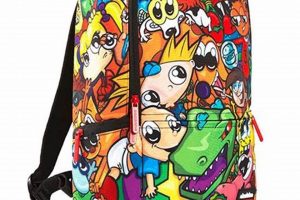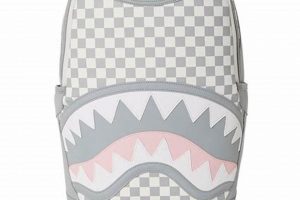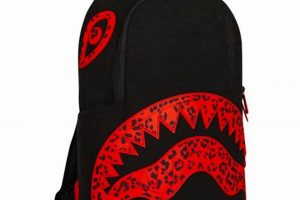These specialized bags are designed to protect belongings in environments where water exposure is common. They provide a dry, secure storage solution for personal items in recreational areas featuring interactive water features. For example, individuals visiting splash pads often utilize these to safeguard electronics, towels, and changes of clothing from getting wet.
The utility of these items extends to ensuring peace of mind and convenience. By preventing water damage, they protect valuable possessions. Historically, individuals resorted to makeshift methods to keep belongings dry in such environments. These dedicated solutions offer a more reliable and practical alternative.
The following discussion will delve into the specific features, materials, and considerations involved in selecting the appropriate bag for use in aquatic play areas, outlining their construction and functionality in greater detail.
Essential Guidance for Selecting Protective Bags
This section offers crucial advice for choosing a bag suited for use around water play areas. The focus is on features and construction that ensure belongings remain dry and secure.
Tip 1: Prioritize Waterproof Material: Opt for bags constructed from materials like PVC, TPU, or coated nylon. These materials offer superior water resistance compared to standard fabrics.
Tip 2: Consider Seam Construction: Look for bags with welded or heat-sealed seams. Stitched seams can allow water to seep through, compromising the bag’s protective capabilities.
Tip 3: Evaluate Closure Systems: Roll-top closures provide a tighter seal than zippers or Velcro, minimizing the risk of water entry. Ensure the closure is properly secured before entering the water area.
Tip 4: Check for Waterproof Ratings: Some bags feature an IP (Ingress Protection) rating. A higher IP rating indicates greater resistance to water and dust. Refer to the manufacturer’s specifications for detailed information.
Tip 5: Assess Capacity and Dimensions: Select a bag that adequately accommodates essential items without being excessively bulky. Consider the dimensions of lockers or storage spaces available at the facility.
Tip 6: Examine Durability: Choose a bag made from robust materials and featuring reinforced stress points. This will ensure longevity and protect contents from accidental impacts.
Tip 7: Inspect for Additional Features: External pockets (if present) should ideally be water-resistant or feature drainage holes. Padded straps can enhance comfort during transport.
Adhering to these guidelines will increase the likelihood of selecting a durable and effective solution for safeguarding personal possessions in potentially wet environments.
The following section will explore specific product recommendations and provide a comparative analysis of available options, taking these factors into account.
1. Waterproof Material
The selection of waterproof material is paramount in the design and functionality of bags intended for use in environments such as spraygrounds. This material directly impacts the protection of contents from water damage, ensuring the preservation of sensitive items such as electronics, clothing, and personal documents.
- Polyvinyl Chloride (PVC)
PVC offers a high degree of water resistance due to its non-porous nature. In practical applications, bags constructed from PVC are often used in marine environments and during water sports. However, PVC can be less flexible and may become brittle in cold temperatures, potentially affecting its long-term durability.
- Thermoplastic Polyurethane (TPU)
TPU is a more flexible alternative to PVC, while still providing significant water resistance. Its abrasion resistance and elasticity make it suitable for bags subjected to frequent use. TPU is often employed in higher-end models where durability and flexibility are prioritized.
- Coated Nylon or Polyester
Nylon and polyester fabrics, when coated with waterproof substances like polyurethane (PU) or durable water repellent (DWR), offer a balance between water resistance, weight, and cost. These materials are commonly used in a wide range of bags, offering adequate protection for light to moderate water exposure. However, the coating can degrade over time with prolonged use or exposure to harsh chemicals.
- Welded Seams and Construction
Regardless of the waterproof material used, the bag’s construction plays a crucial role in preventing water ingress. Welded or heat-sealed seams eliminate stitching holes that could compromise water resistance. This construction method is especially important in bags designed for submersion or prolonged exposure to water spray.
The choice of waterproof material directly correlates with the performance and longevity of bags designed for use in aquatic play areas. Understanding the properties and limitations of each material is essential for selecting a bag that effectively protects contents while meeting the demands of its intended environment. The integration of effective seam construction techniques further enhances the overall waterproof capability.
2. Sealed Seams
Sealed seams are a critical construction element in bags designed for aquatic play environments. The functionality of these bags, intended to protect contents from water exposure, relies heavily on preventing water ingress through seams. Standard stitched seams create perforations that can compromise water resistance, leading to potential damage of sensitive items. Sealed seams, typically achieved through welding or heat-sealing processes, fuse the fabric layers together, creating a waterproof barrier at these vulnerable points. This process is vital for maintaining a dry interior, even when the bag is subjected to splashes, sprays, or brief submersions.
The practical significance of sealed seams is demonstrable in real-world scenarios. Consider an individual at a sprayground who places a smartphone, wallet, and change of clothes inside a bag with standard stitched seams. Exposure to water spray would likely result in moisture penetration, potentially damaging the electronic device and wetting the clothing. In contrast, a bag with sealed seams would prevent this ingress, preserving the dryness of the contents. Manufacturers often employ quality control measures, such as hydrostatic testing, to ensure the integrity of these seals. Bags are filled with air and submerged underwater, allowing for visual inspection to confirm the absence of leaks. This testing helps to validate the effectiveness of the sealing process and provides assurance to consumers.
In conclusion, the effectiveness of bags in aquatic play areas is intrinsically linked to the presence and quality of sealed seams. The absence of such seams or their improper execution undermines the protective capabilities of the bag, rendering it unsuitable for its intended purpose. The understanding of this relationship is essential for consumers seeking to safeguard their belongings in environments characterized by water exposure. The implementation of sealed seam technology significantly enhances the utility and reliability of these bags, providing a dependable solution for maintaining dry contents in challenging conditions.
3. Closure Type
The design of the closure mechanism on bags intended for use in water play environments is a determining factor in its ability to protect contents from water damage. The effectiveness of the material and seam construction can be negated by an inadequate closure. Therefore, careful consideration of closure type is essential for ensuring the bag’s suitability.
- Roll-Top Closures
Roll-top closures involve folding down the top opening of the bag multiple times and securing it with a buckle or clip. This design creates a watertight seal, minimizing water entry even during brief submersions. For example, a roll-top closure, correctly fastened, can prevent water from entering the bag if it is accidentally dropped in a puddle. The effectiveness relies on the user properly folding and securing the top.
- Zipper Closures with Waterproofing
Zippers, when combined with a waterproof coating or seal, can offer moderate protection against water ingress. However, zippers are inherently less watertight than roll-top closures, and the waterproofing can degrade over time. These closures are often seen in bags prioritizing ease of access over absolute water resistance. An example is a splash-proof bag where quick access is needed, accepting a slightly higher risk of moisture exposure.
- Drawstring Closures
Drawstring closures are generally not suitable for bags intended for protection from water, as they offer minimal sealing. While they may provide some protection against light splashes, they are not effective in preventing water from entering the bag during exposure to spray or immersion. They may be found on bags that serve a secondary role within a larger waterproof container, for example, separating wet and dry items.
- Hook-and-Loop (Velcro) Closures
Hook-and-loop closures, while convenient for quick access, provide inadequate water resistance. The gaps between the hook and loop fasteners allow water to easily penetrate the bag. Therefore, this type of closure is generally inappropriate for bags where water protection is a primary requirement. In certain designs, hook-and-loop may be used in conjunction with another closure for added security, but it does not itself provide a waterproof seal.
The selection of closure type should align with the expected level of water exposure and the user’s priorities. Roll-top closures offer the highest level of protection, while zipper closures with waterproofing provide a balance between water resistance and ease of access. Drawstring and hook-and-loop closures are generally unsuitable where water protection is a primary concern. Bags incorporating a combination of closure types may offer enhanced functionality and protection.
4. Capacity
Capacity, in the context of bags designed for use around aquatic play areas, directly influences its utility and practical application. A bag with inadequate capacity limits the user’s ability to carry essential items, thereby diminishing its usefulness. Conversely, excessive capacity results in unnecessary bulk and weight, reducing portability and convenience. The optimal capacity balances the need to accommodate typical items, such as towels, changes of clothing, sunscreen, and electronic devices, with the constraints of portability and storage space at the facility.
The relationship between the capacity and functionality is further illustrated by specific examples. A small, 5-liter bag may be sufficient for carrying a phone and wallet but inadequate for a family’s needs. A larger, 30-liter bag could accommodate the belongings of multiple individuals, but might be difficult to carry for younger children. The selection process, therefore, necessitates consideration of the anticipated load and the user’s physical capabilities. Practical implications include the ability to consolidate belongings into a single, easily manageable bag, reducing the risk of misplacing items and enhancing the overall experience.
In summary, the capacity of bags designed for aquatic environments is a critical determinant of its usefulness and convenience. Selecting a bag with appropriate volume is essential for balancing the need to carry necessary items with considerations of portability and storage. The key challenge lies in accurately assessing the anticipated load and choosing a bag that effectively meets those requirements without compromising manageability. Understanding this relationship leads to more informed purchasing decisions and enhanced user satisfaction.
5. Durability
Durability is a paramount consideration in the selection of bags intended for use in aquatic play areas. The operational environment exposes these items to a variety of stresses, including water exposure, abrasion from rough surfaces, and potential impacts. The ability of the bag to withstand these conditions directly impacts its longevity and its capacity to effectively protect its contents over time.
- Material Strength and Resistance
The inherent strength of the materials used in construction dictates the bag’s ability to resist tearing, puncturing, and general wear. Higher denier fabrics, such as reinforced nylon or PVC tarpaulin, offer superior resistance to abrasion and tearing compared to lighter materials. For instance, a bag constructed from heavy-duty PVC can withstand repeated contact with concrete surfaces, whereas a bag made of thinner nylon may show signs of wear more quickly. The material’s resistance to degradation from UV exposure and chemicals present in treated water is also a significant factor.
- Seam Construction and Reinforcement
Seams represent inherent points of vulnerability in any textile product. Durable construction techniques, such as reinforced stitching or welding, are essential for preventing seam failure under stress. Stress points, such as strap attachment points and corners, should be reinforced to distribute load and minimize the risk of tearing. For example, double-stitched and bar-tacked seams at the strap attachment points significantly increase the bag’s capacity to carry heavy loads without failing. The quality of the thread used also contributes to overall seam durability.
- Hardware Quality and Corrosion Resistance
Buckles, zippers, and other hardware components are integral to the bag’s functionality and must be resistant to corrosion and breakage. Metal components should be constructed from corrosion-resistant alloys, such as stainless steel or aluminum, to prevent degradation from water exposure. Plastic components should be made from durable polymers that can withstand repeated use and exposure to sunlight. A broken buckle or corroded zipper can render the bag unusable, regardless of the integrity of the main material.
- Waterproof Integrity Over Time
Even with waterproof materials and sealed seams, the bag’s ability to maintain its waterproof integrity over extended use is crucial. Repeated flexing, abrasion, and exposure to temperature extremes can compromise the waterproof coating or seam seals. Manufacturers often subject bags to rigorous testing, including simulated wear and tear and hydrostatic pressure tests, to assess their long-term waterproof performance. Consumers should consider warranties and reviews to gauge the product’s durability in real-world conditions.
In summary, durability, as it relates to bags designed for aquatic environments, encompasses a complex interplay of material strength, construction techniques, hardware quality, and sustained waterproof performance. The selection of a durable bag requires careful consideration of these factors to ensure that it can withstand the rigors of frequent use in challenging conditions, providing reliable protection for belongings over an extended lifespan.
6. Comfort
The ergonomic design of bags used at aquatic play areas directly impacts user experience and practicality. The ability to comfortably carry belongings while navigating these environments is a key consideration in product selection and usage.
- Padded Shoulder Straps
The presence of padded shoulder straps distributes the weight of the bag evenly across the shoulders, reducing strain and discomfort, particularly when carrying heavier loads. Examples include bags with high-density foam padding, which cushions the shoulders and prevents pressure points. This design feature is especially important for extended periods of use or when the bag is filled with bulky items such as towels and clothing. The ergonomic design of the straps, including their width and contour, further enhances comfort and stability.
- Adjustable Straps
Adjustable straps allow users to customize the fit of the bag to their individual body size and shape, improving balance and weight distribution. A properly adjusted bag sits comfortably against the back, preventing it from swinging or shifting during movement. This feature is particularly beneficial for children or individuals of smaller stature. The adjustability of the sternum strap is a related consideration, as it helps to secure the shoulder straps and prevent them from slipping off the shoulders.
- Back Panel Design
The design of the back panel contributes significantly to overall comfort by providing cushioning and promoting ventilation. Padded back panels, often incorporating mesh fabric, enhance airflow and reduce perspiration, preventing discomfort and overheating. Some designs include contoured padding that conforms to the natural curvature of the spine, providing additional support and reducing pressure points. The effectiveness of the back panel design directly affects the user’s ability to carry the bag comfortably for extended periods.
- Weight Distribution
The internal organization of the bag and the placement of compartments can affect the overall weight distribution, impacting balance and comfort. Strategically positioned compartments help to distribute the load evenly, preventing the bag from feeling lopsided or unbalanced. Lower placement of heavier items improves stability and reduces strain on the shoulders and back. Considerations of weight distribution are particularly relevant for larger bags with multiple compartments.
The preceding facets demonstrate that comfort is a multifaceted attribute influenced by various design elements. Bags designed with attention to these ergonomic considerations enhance the user experience by promoting comfortable and stable carrying, allowing for greater enjoyment and ease of movement within water play environments. The integration of padded straps, adjustable features, breathable back panels, and strategic weight distribution contributes to an overall design that prioritizes comfort and functionality.
7. Portability
Portability is a fundamental attribute influencing the utility of bags intended for use in aquatic play areas. The ease with which these bags can be carried and transported directly affects their practical application and user satisfaction. Bags designed for such environments must balance the capacity to carry essential items with the need for maneuverability and convenient handling.
- Weight Considerations
The overall weight of the bag, both when empty and when fully loaded, is a primary factor affecting portability. Lighter materials and streamlined designs contribute to reduced weight, making the bag easier to carry for extended periods. For example, bags constructed from lightweight nylon or polyester are inherently more portable than those made from heavier PVC or canvas. The weight distribution within the bag also influences perceived portability; a bag with an unevenly distributed load can feel heavier and more cumbersome than one with balanced weight distribution.
- Size and Dimensions
The physical dimensions of the bag impact its ability to be carried comfortably and stored conveniently. Smaller, more compact bags are easier to maneuver through crowded areas and fit into lockers or storage spaces. However, overly small bags may lack the capacity to carry all necessary items. The optimal size balances the need for adequate storage with the constraints of portability and storage space. For instance, a bag designed to fit within the dimensions of a standard locker offers enhanced portability and storage convenience.
- Carrying Options
The availability of multiple carrying options enhances portability and adaptability. Bags with both shoulder straps and handles offer versatility, allowing the user to choose the most comfortable and convenient carrying method. Padded handles and adjustable shoulder straps further improve comfort and ease of transport. For example, a bag with a removable shoulder strap can be carried as a tote when lightly loaded or worn over the shoulder when carrying heavier items, adapting to the user’s needs.
- Collapsibility and Storage
The ability to collapse or fold the bag when not in use contributes to its overall portability and storage convenience. Bags constructed from flexible materials can be easily folded and stored in a smaller space, making them ideal for travel or situations where storage space is limited. This feature is particularly beneficial for individuals who frequently visit aquatic play areas but do not want to dedicate a large amount of storage space to the bag when it is not in use. A bag that can be compressed into a small pouch offers enhanced portability and storage versatility.
In conclusion, the portability of bags designed for aquatic environments encompasses a combination of factors related to weight, size, carrying options, and storage convenience. The ideal bag balances the need for adequate storage capacity with the constraints of weight, size, and ease of handling, providing a practical and convenient solution for carrying belongings in potentially wet environments. Understanding these facets informs purchasing decisions and promotes user satisfaction with the product.
Frequently Asked Questions
The following questions address common concerns regarding the selection and usage of bags designed for environments such as spraygrounds, offering guidance on optimal product choice and maintenance.
Question 1: What defines a bag as specifically suitable for use around spraygrounds?
A bag designated for sprayground use typically incorporates waterproof or water-resistant materials, sealed seams, and secure closure mechanisms to protect contents from water exposure. Durability and ease of cleaning are also key considerations.
Question 2: How can the waterproof integrity of a bag be assessed prior to purchase?
Examine the product specifications for waterproof ratings (e.g., IPX standards) and material composition. Seek out reviews detailing real-world performance in wet conditions. Physical inspection for robust seam construction and reliable closure systems is also advisable.
Question 3: What is the expected lifespan of a bag used frequently at spraygrounds?
Lifespan varies based on material quality, construction, and usage intensity. High-quality bags, properly maintained, can endure for several seasons. Signs of wear, such as seam degradation or material abrasion, indicate the need for replacement.
Question 4: Are specific cleaning procedures recommended for bags exposed to treated water at spraygrounds?
Rinse the bag thoroughly with fresh water after each use to remove chlorine and other chemical residues. Mild soap and water can be used for more intensive cleaning. Ensure the bag is completely dry before storing to prevent mildew growth.
Question 5: What types of closure systems offer the most reliable protection against water ingress?
Roll-top closures generally provide the most secure waterproof seal. Zippers with waterproof coatings offer moderate protection, while drawstring closures are generally unsuitable for wet environments.
Question 6: How should electronic devices be protected within a bag at a sprayground?
While a suitable bag provides a degree of protection, it is advisable to use additional waterproof pouches or dry bags for sensitive electronic devices. This provides a redundant layer of protection against water damage.
In summary, careful selection and proper maintenance are essential for ensuring the effectiveness and longevity of bags used in aquatic play environments. Adherence to recommended cleaning procedures and proactive inspection for signs of wear will maximize the protective capabilities of these items.
The following section will address specific product recommendations based on the criteria outlined above.
Spraygrounds Backpacks
This exposition has detailed critical features for specialized bags designed for aquatic environments. Emphasis has been placed on material selection, seam construction, closure mechanisms, capacity considerations, durability assessments, comfort attributes, and portability factors. Each element contributes significantly to the overall utility and protective capabilities of these items, ensuring the safe and convenient transport of belongings in potentially wet conditions.
Given the demonstrated importance of safeguarding personal items in recreational water areas, the informed selection of an appropriate bag is paramount. Understanding the inherent trade-offs between various features allows individuals to make well-reasoned purchasing decisions. Prioritizing protective features contributes to the preservation of valuables and enhances the overall user experience, underscoring the value of dedicated protective bags in environments where water exposure is prevalent.







